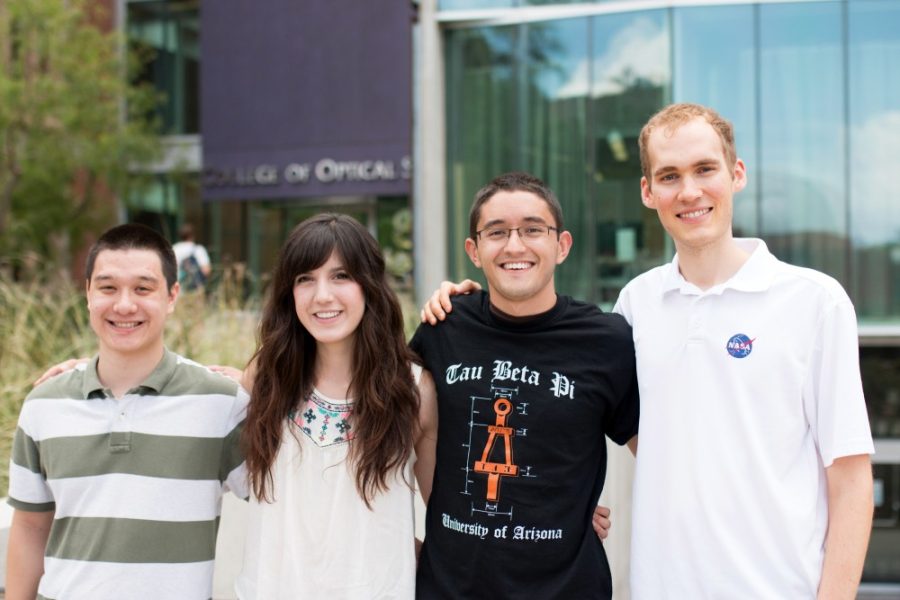If you’ve ever stepped into the College of Optical Sciences at the UA, it has something pointedly futuristic about it. In the lobby stands a hefty sphere of glass, propped on a stand and receiving ample light from beyond the large northerly glass walls.
“You can form an image of the landscape by placing a piece of paper behind it; you’ll see that the image is actually curved and upside down,” said Travis Sawyer, a senior studying optical sciences and engineering. “Seeing people do this is how we tell who’s new here.”
Sawyer along with Stephanie Guzman, Nicholas Lyons and Fabian Wildenstein, all seniors studying optical sciences and engineering, have certainly earned their way into this challenging and bright world of optics—they recently won the Robert S. Hilbert Memorial Optical Design Competition, a competition housed by Synopsys to encourage the use of their optics imaging software, Code V. This hefty achievement is amplified by the fact that they are amongst the youngest ever to win.
“Most of the winners have been graduate students,” said Yuzura Takashima, an associate professor for the College of Optical Sciences and the team’s adviser, “This was the first group pursuing their B.S. to win.”
The group members have an explanation for why they were successful despite not being graduate students like the rest of the winners.
“I think it helped that we got along so well,” Wildenstein said. Certainly each had an enthusiasm for their field of a study, a discipline that combines elegant trigonometry with the topsy-turvy world of mirrors, distorted images and redirecting light itself.
“My first introduction to optics was one of my natural science gen eds, called Light, Color and Vision,” Guzman said. “I was excited about everything we studied. I remember going back to my roommate and being like, ‘Look at that Polaris!’”
But even with their passion and teamwork, it wasn’t an easy task. The students started with only basic knowledge, and had to learn the program as well as come up with an idea. The original inspiration came from a mission to one of Saturn’s moons back in the ’90s.
The imager that was deployed captured data about the atmosphere of Titan. It rotated and took images of the atmosphere, but was essentially useless on the actual terrain of the moon. The team’s idea was to make and optimize an imager which was high-resolution enough to collect data in nothing less than the liquid methane seas of Titan.
The key to their task was Synopsys’s program, designed for imaging optics and programmed to do the mathematical heavy lifting. The hardest part about utilizing the actual Code V program?
“Opening it up,” said Alonzo Espinoza, an optical sciences graduate student who guided the team in their project. Starting as they had with a basic knowledge of working with such complex technology, it’s clear how strong the team was.
In a conference room in the Meinel Optical Sciences building, they chat cheerfully amongst each other. Around discussions of how they’ll spend the reward from winning, Lyons and Sawyer cite where they’re applying to graduate school, new innovations in optics and plans for the semester.
“Tuition…” Lyons said.
“Tuition,” Sawyer agreed, nodding.
Follow Alexandria Farrar on Twitter









